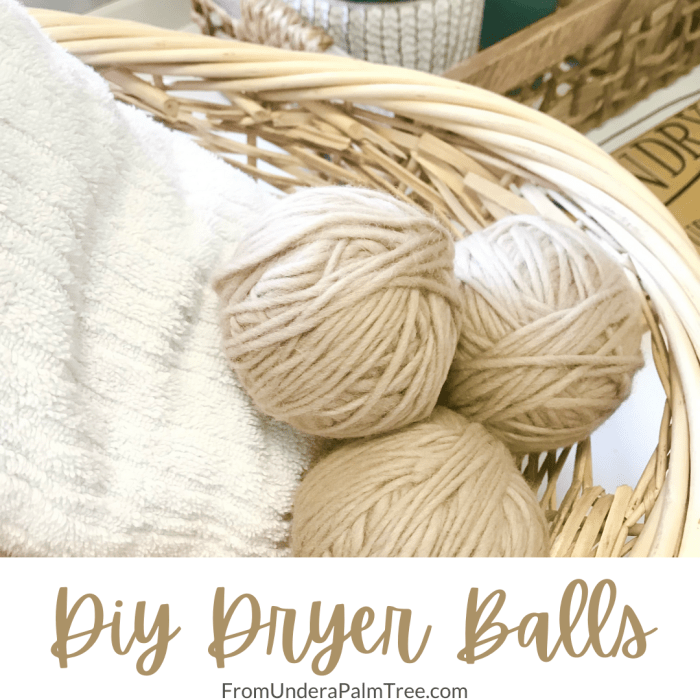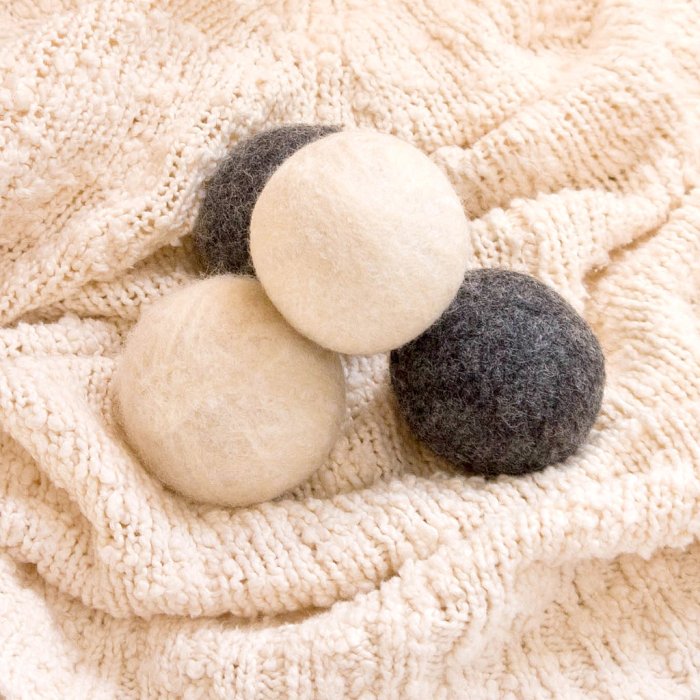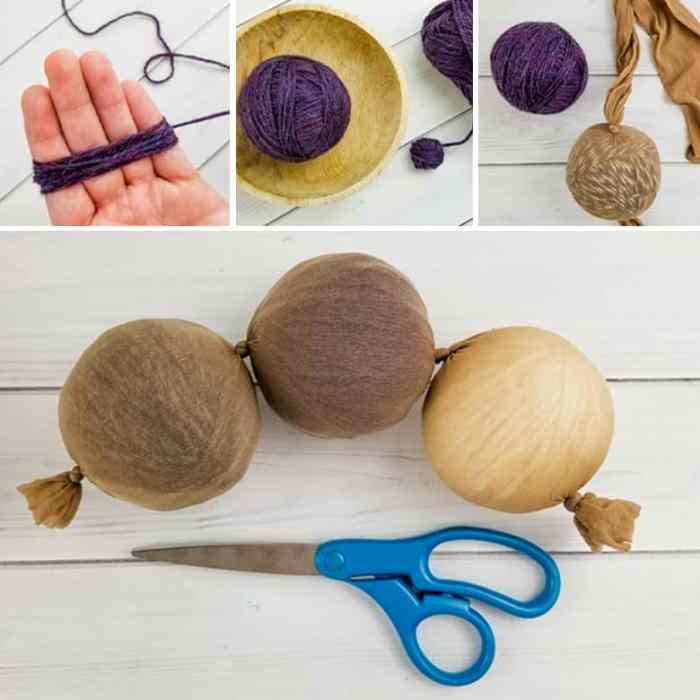DIY dryer balls are a simple and eco-friendly alternative to store-bought dryer sheets. They are made from natural materials like wool, felt, or even dryer lint, and can be infused with essential oils for a fresh scent. Not only are DIY dryer balls a great way to save money, but they also help reduce your environmental impact by eliminating the need for disposable dryer sheets.
The benefits of using DIY dryer balls extend beyond their eco-friendliness. They help to soften clothes naturally, reduce static cling, and even shorten drying time. By adding a few drops of essential oil, you can customize the scent of your laundry and create a relaxing atmosphere in your home.
DIY Dryer Ball Recipes

DIY dryer balls are a great way to reduce your reliance on single-use dryer sheets and save money in the long run. These balls are also eco-friendly and can be made with a variety of materials found around your home. Here are three different recipes for DIY dryer balls.
Wool Dryer Balls
Wool dryer balls are a popular choice for DIY dryer balls. They are soft, durable, and effective at reducing drying time. Wool dryer balls are also naturally hypoallergenic and can be used for multiple loads of laundry.
- Ingredients:
- 100% wool felt (enough to make 4-inch balls)
- Scissors
- Needle and thread (optional)
- Instructions:
- Cut the wool felt into squares, approximately 4 inches wide.
- Layer 4-5 squares of wool felt on top of each other.
- Use your fingers to shape the felt into a ball. You can use a small bowl or cup to help you shape the ball.
- Once the ball is formed, sew the edges together with a needle and thread (optional). This will help to keep the ball together and prevent it from unraveling.
- Repeat steps 1-4 to create more dryer balls.
Fabric Scrap Dryer Balls
Fabric scrap dryer balls are a great way to use up leftover fabric scraps. They are also a good option for people who are allergic to wool.
DIY dryer balls are a great eco-friendly alternative to dryer sheets, but if you’re experiencing persistent skin irritation, you might want to consult a doctor. They may recommend a course of prednisone tablets to manage any underlying inflammation. Once your skin is clear, you can safely return to using your DIY dryer balls, enjoying their natural fragrance and gentle drying power.
- Ingredients:
- Fabric scraps (cotton, linen, or other natural fibers)
- Scissors
- Needle and thread
- Instructions:
- Cut the fabric scraps into squares, approximately 4 inches wide.
- Layer 4-5 squares of fabric on top of each other.
- Use your fingers to shape the fabric into a ball. You can use a small bowl or cup to help you shape the ball.
- Once the ball is formed, sew the edges together with a needle and thread.
- Repeat steps 1-4 to create more dryer balls.
Tennis Ball Dryer Balls
Tennis balls are a surprisingly effective alternative to dryer balls. They are already round and durable, and they can be used for multiple loads of laundry.
- Ingredients:
- Tennis balls
- Instructions:
- Simply place the tennis balls in the dryer with your laundry. They will help to separate the clothes and prevent them from clumping together.
Essential Oils for DIY Dryer Balls

Adding essential oils to your DIY dryer balls can transform your laundry routine. Not only do they provide a delightful scent to your clothes, but they also offer numerous benefits.
Essential Oils Suitable for Dryer Balls
Essential oils are concentrated plant extracts with a variety of properties. When used in dryer balls, they can soften fabrics, reduce static cling, and even act as natural fabric fresheners.
Here are some popular essential oils suitable for use in dryer balls:
- Lavender: Known for its calming and relaxing properties, lavender essential oil can help create a sense of peace and tranquility in your home. It also has natural antibacterial and antifungal properties.
- Tea Tree: Tea tree oil is a natural antiseptic and antifungal agent. It can help to eliminate odors and prevent mildew growth in your laundry.
- Eucalyptus: Eucalyptus oil is known for its refreshing and invigorating scent. It can also help to relieve congestion and promote clear breathing.
- Lemon: Lemon essential oil is a natural disinfectant and can help to brighten and freshen your laundry. It also has a cheerful and uplifting scent.
- Orange: Orange essential oil has a sweet and citrusy scent that can help to lift your mood. It is also known for its cleaning properties.
Safely Incorporating Essential Oils into Dryer Ball Recipes
It’s crucial to use essential oils safely when making DIY dryer balls. Here’s a step-by-step guide:
- Choose high-quality essential oils: Look for oils that are 100% pure and therapeutic grade.
- Start with a small amount: Add a few drops of essential oil to your dryer ball recipe. You can always add more if desired.
- Avoid mixing too many oils: Mixing several oils can create a strong scent that may be overpowering.
- Test on a small area: Before using a new essential oil on a full load of laundry, test it on a small area of fabric to ensure it does not cause any discoloration or irritation.
- Store properly: Keep your essential oils in a cool, dark place, away from direct sunlight.
DIY Dryer Ball Variations
Basic dryer balls can be used for a long time, but adding some variations can make them even more useful and enjoyable. This section explores some creative ways to customize dryer balls to meet your needs and preferences.
Scented Dryer Balls
Scented dryer balls offer a pleasant fragrance to your laundry. You can add essential oils to your dryer balls to create a calming or invigorating aroma. Some popular essential oils for laundry include lavender, tea tree, lemon, and eucalyptus. Simply add a few drops of your chosen essential oil to your dryer balls before adding them to the dryer.
Decorative Dryer Balls
Decorative dryer balls can add a touch of personality to your laundry room. You can use fabric scraps, yarn, or even old clothing to create unique and colorful dryer balls.
- For example, you can use fabric scraps to create patchwork dryer balls or knit yarn around a base ball to create a fluffy, colorful dryer ball.
- You can also use fabric markers or paint to decorate dryer balls with patterns, designs, or even your initials.
Dryer Balls with Added Features, Diy dryer balls
You can also incorporate additional features into your dryer balls to enhance their functionality.
- For example, you can sew a small pocket into a dryer ball to hold dryer sheets or fabric softener.
- Another option is to add small beads or stones to the dryer ball to increase its weight and tumbling action, which can help to reduce static cling.
Benefits and Drawbacks of Different Materials
Different materials used in dryer ball variations can offer unique benefits and drawbacks.
- For example, wool dryer balls are known for their durability and ability to absorb moisture, but they may shrink or felt over time.
- Fabric scraps are a great way to upcycle old clothing, but they may not be as durable as wool or felt.
- Adding essential oils can provide a pleasant fragrance, but it’s important to use only a few drops to avoid overpowering the scent of your laundry.
Environmental Impact of DIY Dryer Balls

The environmental impact of DIY dryer balls compared to store-bought options depends largely on the materials used and the manufacturing process of the store-bought options. While store-bought dryer balls are often made from synthetic materials like plastic, DIY dryer balls can be crafted from natural and sustainable materials.
Sustainable Sourcing of Materials
When sourcing materials for DIY dryer balls, prioritize natural and sustainable options to minimize environmental impact.
- Wool: Choose wool from ethically sourced and sustainably managed farms. Look for certifications like “Organic” or “Fair Trade” to ensure responsible practices.
- Felt: Opt for felt made from recycled materials or natural fibers like wool or cotton.
- Essential Oils: Select essential oils from reputable brands that use sustainable harvesting practices and are certified organic.
Minimizing Environmental Footprint
Here are some tips for reducing the environmental footprint of DIY dryer balls:
- Reuse: Instead of purchasing new materials, consider repurposing old socks, fabric scraps, or even tennis balls for dryer balls.
- Reduce Waste: Avoid using excessive amounts of materials or creating unnecessary waste during the crafting process.
- Wash Wisely: Use a gentle detergent and avoid harsh chemicals when washing your DIY dryer balls.
- Compost: When your DIY dryer balls eventually wear out, consider composting them if made from natural materials like wool or felt.
DIY Dryer Balls for Sensitive Skin
Dryer balls are a great way to soften clothes and reduce static cling without using harsh chemicals. They’re also a more sustainable alternative to dryer sheets, which can irritate sensitive skin. If you have sensitive skin, you may be hesitant to use dryer balls because you’re worried about potential skin irritation. However, with a few simple precautions, you can make DIY dryer balls that are safe and gentle for even the most sensitive skin.
Benefits of DIY Dryer Balls for Sensitive Skin
DIY dryer balls offer several benefits for individuals with sensitive skin. These benefits include:
- Hypoallergenic: DIY dryer balls can be made with natural and hypoallergenic ingredients, reducing the risk of allergic reactions and skin irritation.
- Gentle on Skin: Natural ingredients used in DIY dryer balls are less likely to cause skin irritation or dryness compared to harsh chemicals found in dryer sheets.
- Reduced Static Cling: DIY dryer balls help reduce static cling, minimizing the need for fabric softeners, which can also irritate sensitive skin.
- No Added Fragrances: You can control the scent of your DIY dryer balls by using essential oils, allowing you to choose fragrance-free options or opt for gentle, hypoallergenic scents.
Hypoallergenic DIY Dryer Ball Recipes
Here are a few recipes for hypoallergenic DIY dryer balls:
- Wool Dryer Balls: Wool dryer balls are a popular choice for sensitive skin. They are naturally hypoallergenic and gentle on clothes. You can purchase wool dryer balls online or at craft stores.
- Felt Dryer Balls: Felt dryer balls are another great option for sensitive skin. They are made from wool fibers that are felted together, creating a soft and durable ball. You can purchase felt dryer balls online or at craft stores.
- DIY Felt Dryer Balls: You can also make your own felt dryer balls using felt scraps or wool yarn. To make felt dryer balls, simply cut felt scraps or wool yarn into small squares. Then, roll the squares into balls and sew them together. You can also use a needle and thread to attach felt scraps to wool dryer balls, adding extra layers of softness and absorption.
- DIY Wool Dryer Balls: To make DIY wool dryer balls, you can use wool roving, which is a type of wool that is not yet spun into yarn. Simply roll the wool roving into balls and then felt them in a washing machine or dryer. You can also use a felting needle to felt the wool roving by hand.
Preventing Skin Irritation from DIY Dryer Balls
While DIY dryer balls are generally safe for sensitive skin, there are a few things you can do to minimize the risk of irritation:
- Wash New Dryer Balls Before Use: Always wash new dryer balls before using them for the first time. This will help remove any excess dye or chemicals that may be present.
- Use Gentle Detergent: Use a gentle detergent that is free of dyes and fragrances. This will help prevent skin irritation and keep your clothes soft and clean.
- Avoid Overloading the Dryer: Overloading the dryer can trap moisture and heat, making it more likely for clothes to become irritated. Make sure to leave enough space for air circulation.
- Use Essential Oils Sparingly: If you choose to add essential oils to your DIY dryer balls, use them sparingly. Some essential oils can irritate sensitive skin. Consider using gentle essential oils like lavender or chamomile. If you are unsure, patch test a small amount of the diluted essential oil on your skin before using it in your dryer balls.
- Wash Clothes Thoroughly: Always wash your clothes thoroughly after using DIY dryer balls to remove any lingering lint or residue.
DIY Dryer Balls: A Sustainable Choice
Beyond their ability to soften clothes and reduce drying time, DIY dryer balls offer a sustainable and cost-effective alternative to traditional dryer sheets. By choosing this eco-friendly option, you can contribute to a greener lifestyle and save money in the long run.
Sustainability and Cost Savings
The benefits of DIY dryer balls extend far beyond just softening your laundry. They offer a sustainable and cost-effective alternative to traditional dryer sheets, which often contain harsh chemicals and contribute to landfill waste. Here’s how:
- Reduced Waste: Unlike disposable dryer sheets, DIY dryer balls are reusable, eliminating the need for constant replacements and reducing waste. With proper care, they can last for years, significantly decreasing your environmental footprint.
- Cost Savings: The initial investment in materials for DIY dryer balls is minimal, and they can save you money in the long run. You won’t have to purchase expensive dryer sheets regularly, leading to substantial cost savings over time.
- Chemical-Free Laundry: DIY dryer balls are free from harmful chemicals and fragrances, making them a safer choice for sensitive skin and allergies. They also reduce the amount of chemicals released into the environment during the drying process.
Reducing Waste and Promoting Eco-Friendly Practices
The decision to switch to DIY dryer balls has a positive impact on the environment by minimizing waste and promoting eco-friendly practices.
- Landfill Reduction: By choosing reusable dryer balls, you contribute to reducing the amount of waste that ends up in landfills. This helps conserve natural resources and minimizes the environmental impact of waste disposal.
- Sustainable Lifestyle: Embracing DIY dryer balls is a step towards a more sustainable lifestyle. It encourages a mindful approach to consumption and promotes the use of reusable alternatives to disposable products.
- Environmental Awareness: Using DIY dryer balls raises awareness about the environmental impact of everyday choices. It encourages a conscious effort to make more sustainable decisions and promotes a greener approach to laundry care.
A Sustainable and Responsible Choice
DIY dryer balls represent a sustainable and responsible choice for consumers who are conscious of their environmental impact. They offer a practical and affordable way to reduce waste, save money, and contribute to a greener planet. By choosing DIY dryer balls, you can make a positive difference in your everyday life and promote a more sustainable future.
Whether you’re looking to reduce your environmental footprint, save money, or simply add a touch of personalization to your laundry routine, DIY dryer balls are a fantastic option. They are easy to make, customizable, and provide a natural and effective way to care for your clothes. With a little creativity and some simple ingredients, you can easily create your own DIY dryer balls and enjoy the many benefits they offer.
